When it comes to the Doberman dog vs Rottweiler, both are strong, loyal, and intelligent breeds. A Doberman stands between 26-28 inches tall, weighing 60-100 pounds, while a Rottweiler typically weighs 80-135 pounds. These physical differences are important when choosing the right dog for your lifestyle.
The Doberman has a sleek, athletic build, while the Rottweiler is more solid and stocky. Dobermans are known for their high energy, and Rottweilers have strong guarding instincts. Both breeds require proper training and attention to thrive in a family environment.
Quick Navigation
Which breed is more suitable for first-time dog owners, Doberman or Rottweiler?
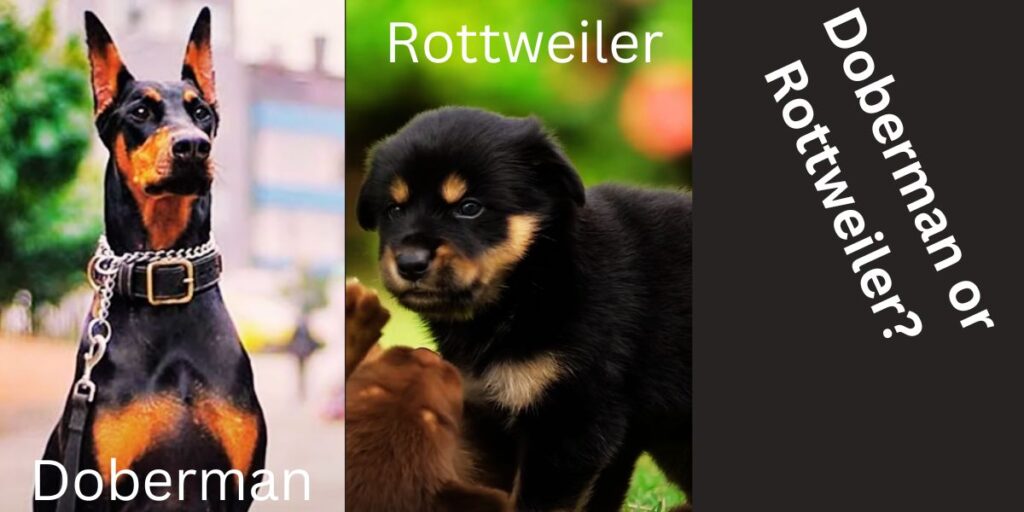
For first-time dog owners, the Rottweiler is often a better choice. While both breeds are intelligent, Rottweilers tend to be more laid-back and easier to manage compared to Dobermans, who are high-energy and require consistent mental and physical stimulation.
Rottweilers are naturally protective and loyal, making them excellent family dogs, but they may need proper training to avoid dominance issues. Dobermans, on the other hand, can be more demanding in terms of exercise and socialisation. Overall, Rottweilers may be more forgiving and adaptable for new dog owners, especially with early training and proper care.
Read more: How the Belgian Malinois Dog vs German Shepherd compares in terms of temperament, training, and more.
Doberman Dog vs Rottweiler Differences
Historical Background
When you’re considering getting a dog, it’s helpful to understand the history of the breed you’re choosing. Both the Doberman Pinscher and the Rottweiler have rich histories that shape their characteristics today.
Doberman Pinscher

The Doberman Pinscher was first bred in Germany in the 1890s by a tax collector named Karl Friedrich Louis Dobermann. He wanted a dog that could protect him while he collected taxes, and he succeeded, creating a breed known for loyalty and intelligence.
Today, Dobermans are often seen as protective and alert, with a history of working as police, military, and service dogs. Their life expectancy typically ranges between 10-12 years, and they weigh around 60-100 pounds.
Rottweiler
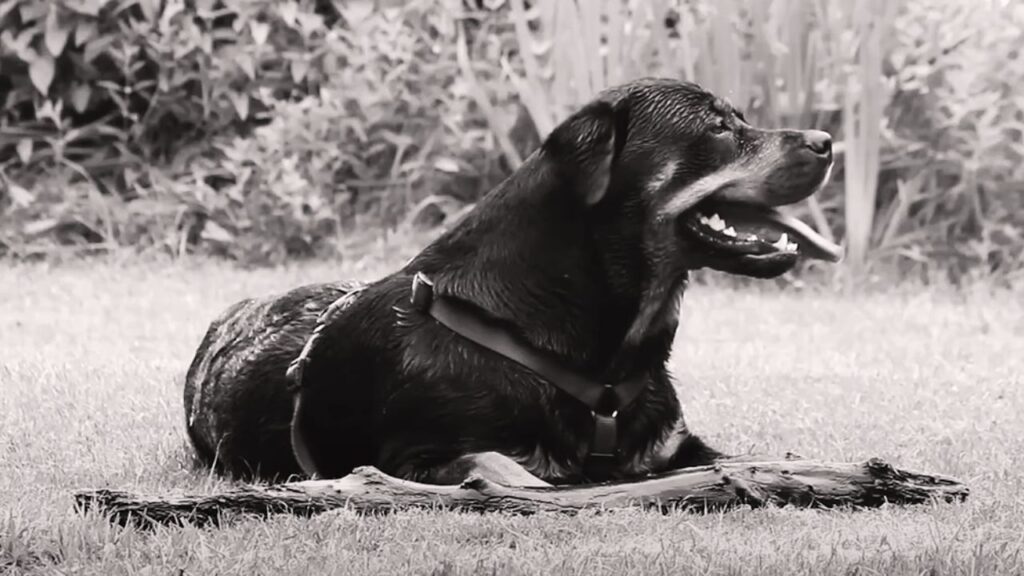
The Rottweiler’s roots trace back to ancient Roman times when they were used as herd dogs and guard dogs for Roman soldiers. Their name comes from the town of Rottweil in Germany, where they were used for pulling carts and guarding livestock.
These dogs have historically been loyal and strong protectors, playing roles as police dogs, search-and-rescue animals, and even therapy dogs. Rottweilers usually live between 8-10 years and weigh around 80-135 pounds.
Physical Characteristics
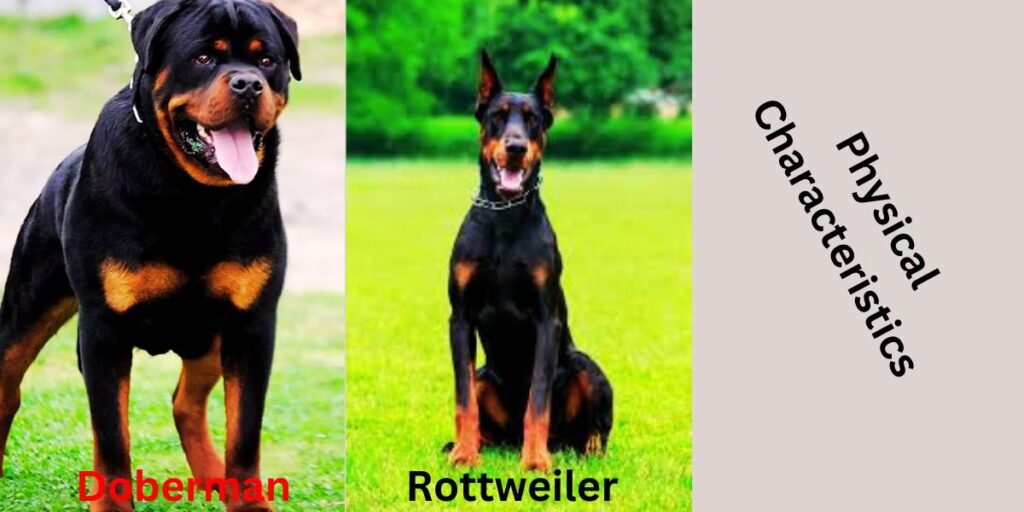
When deciding between a Doberman Pinscher and a Rottweiler, their physical appearance plays a big role in your choice. Both breeds are large, muscular, and imposing, but they differ in some key aspects.
Size and Build
The Doberman is a leaner dog, standing between 26 to 28 inches tall at the shoulder and weighing around 60 to 100 pounds. On the other hand, the Rottweiler is bulkier, typically reaching 24 to 27 inches in height and weighing 85 to 135 pounds. The Rottweiler’s wider frame gives it a heavier appearance compared to the sleek Doberman.
Coat and Colors
Both dogs have short, dense coats, but their colors set them apart. Dobermans are known for their black and tan coats, while some can also be red or blue. Rottweilers, however, have a black coat with tan markings on the face, chest, and legs. While both breeds shed moderately, a Doberman’s coat requires less maintenance than a Rottweiler’s
Temperament and Personality
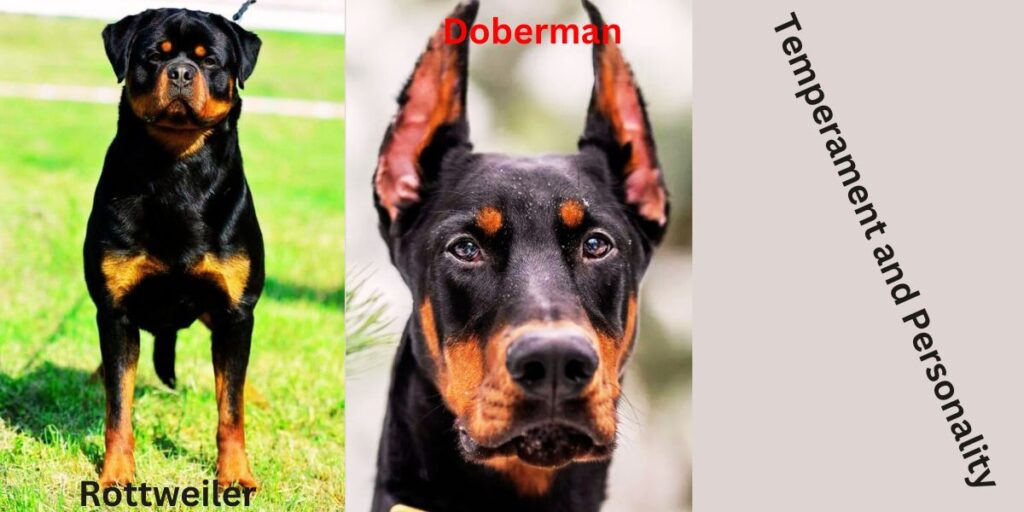
When it comes to choosing between a Doberman and a Rottweiler, understanding their temperament and personality is essential. Both breeds are known for their strong, loyal natures, but they have their unique traits that set them apart.
Doberman Pinscher Temperament
Dobermans are incredibly intelligent and protective dogs. They are typically very loyal to their families and can be excellent guard dogs. On average, they stand around 24–28 inches tall and weigh between 60–100 pounds, and their devotion makes them great companions for active individuals.
Rottweiler Temperament
Rottweilers are also known for their loyalty, but they are often more laid-back compared to Dobermans. They stand between 22–27 inches tall and weigh between 80–135 pounds, making them slightly heavier. While they can be assertive, they are also known for their calm demeanor when well-socialized from a young age.
Energy Levels: Doberman vs. Rottweiler
Dobermans tend to have higher energy levels, often requiring more exercise. They need at least 1–2 hours of physical activity per day to keep them mentally and physically engaged. Rottweilers are a bit more relaxed, but they still require a good amount of daily exercise, typically around 1 hour.
Intelligence and Trainability
Both breeds are highly intelligent, but Dobermans are often easier to train due to their quick learning abilities. Dobermans score high on intelligence rankings, with some studies putting them in the top 5 smartest dog breeds. Rottweilers, while also smart, might take a bit more time and patience with training but are still very capable.
Read more: Explore the differences between the Rottweiler Dog vs German Shepherd to make an informed decision for your next pet.
Health Considerations

When choosing between a Doberman and a Rottweiler, health is one of the most important factors to consider. Both breeds have their unique health challenges, and knowing what to expect can help you take better care of your dog.
Common Health Issues
The Doberman Pinscher is prone to certain health conditions like dilated cardiomyopathy (DCM), which affects the heart, and hip dysplasia, a common issue in large breeds. On average, Dobermans live around 10 to 12 years.
Rottweilers, on the other hand, can experience health problems like hip and elbow dysplasia, and osteosarcoma (bone cancer). Their average lifespan is 8 to 10 years, which is slightly shorter than that of the Doberman.
Preventive Care
For both breeds, regular vet check-ups are essential. Dobermans should have regular heart screenings due to their higher risk of DCM, while Rottweilers need regular joint checks. Vaccination schedules should be followed to prevent common illnesses.
Ensuring that your dog maintains a healthy weight is also crucial. Obesity can exacerbate joint problems, particularly in Rottweilers, leading to more serious issues over time.
Exercise and Activity Needs

When considering a Doberman or Rottweiler, it’s important to think about their exercise needs. Both breeds are energetic, so you’ll need to ensure they get enough physical activity to stay healthy and happy.
Physical Exercise
Both Dobermans and Rottweilers are highly active breeds that require regular exercise. A minimum of 30 to 60 minutes of daily activity is essential for both breeds. This could include walks, runs, or playtime in a secured yard to keep them physically fit.
Mental Stimulation
These dogs also need mental stimulation. For Dobermans and Rottweilers, activities like puzzle toys, training sessions, and interactive games help keep their minds sharp. Aim for at least 15-20 minutes of mental engagement each day to prevent boredom.
By meeting their physical and mental needs, both breeds will remain balanced and less likely to develop behavioural issues. If you’re an active person who enjoys exercise, either breed can be a great match.
Read more: Discover the key distinctions in the Alsatian Dog vs German Shepherd debate to help you choose the right breed.
Grooming and Maintenance
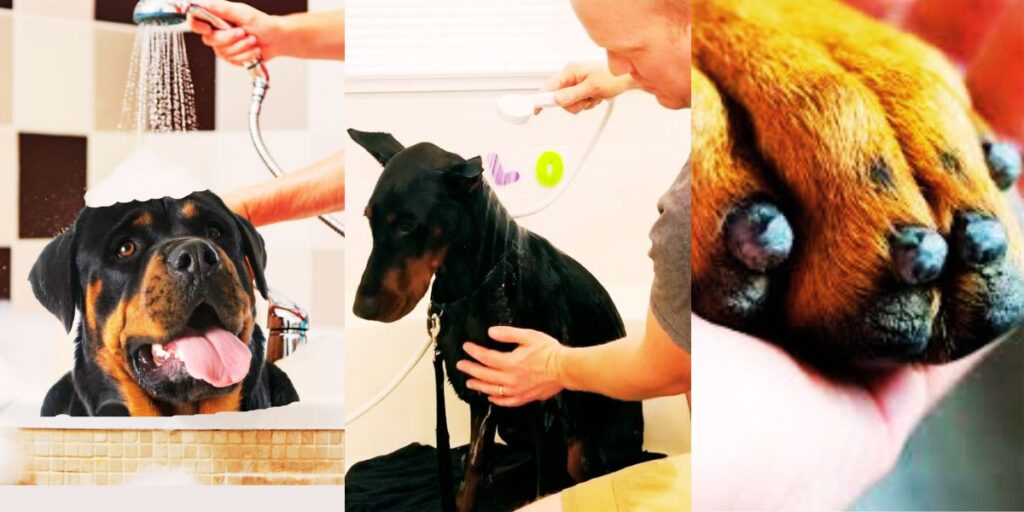
When it comes to grooming, both Dobermans and Rottweilers require attention, though they differ in some aspects. Let me take you through what it’s like maintaining these amazing breeds.
Coat Care
Dobermans have short, sleek coats that require minimal maintenance. I’ve found that a weekly brushing is usually enough to keep their fur shiny and healthy, and they shed moderately, especially during seasonal changes.
Rottweilers, on the other hand, have a dense double coat, which needs more attention. A regular brushing, at least twice a week, helps manage shedding, which can be heavier than the Doberman’s, especially during spring and fall.
Bathing and Hygiene Practices
Bathing both breeds doesn’t need to be frequent every 6-8 weeks works fine. However, Rottweilers tend to get a bit smellier due to their thicker coat, and I’ve noticed they sometimes need an extra wash.
For both dogs, it’s important to use a gentle dog shampoo to avoid skin irritation. Also, I’ve found that maintaining their ears clean and free from wax buildup is crucial for both, especially for the Rottweiler, which can be more prone to ear infections.
Nail Trimming, Ear Cleaning, and Dental Care
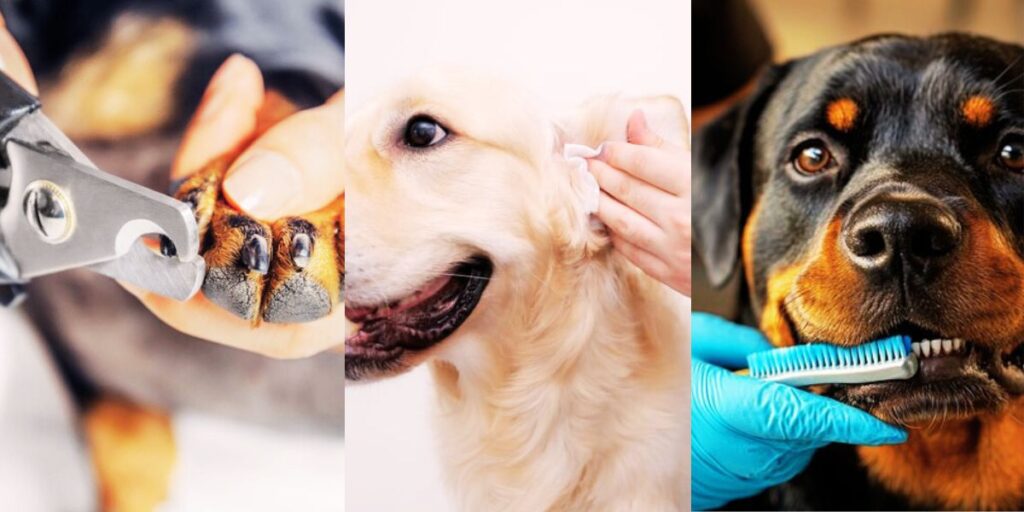
Both breeds need regular nail trimming to prevent discomfort. I recommend trimming them once a month, or when you hear them clicking on hard floors. For ear cleaning, I usually wipe them with a damp cloth, focusing on the Rottweiler’s more pronounced ear flaps. Dental hygiene is often overlooked but super important. Brushing their teeth a few times a week helps prevent dental issues and bad breath, which is something both dogs can experience if left unchecked.
Compatibility with Families and Other Pets
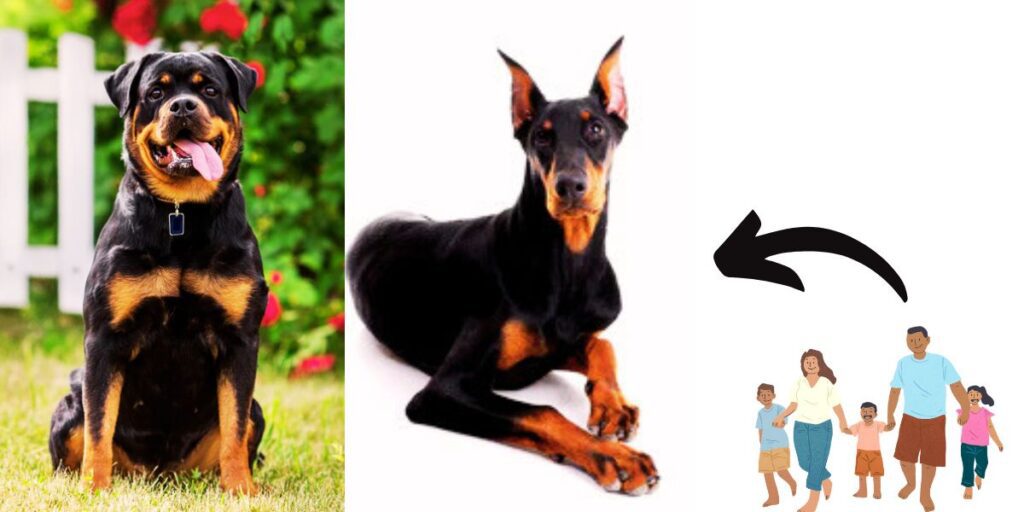
When choosing a dog, it’s important to think about how they’ll fit into your family and how they interact with other pets. Let’s take a closer look at how both the Doberman Pinscher and the Rottweiler fare in these areas.
Family Dynamics
Both the Doberman and the Rottweiler are known for their loyalty and protective instincts, which make them excellent family dogs. A Doberman, on average, is calm around children, but their high energy requires supervision—especially with younger kids. Rottweilers are similarly protective, weighing between 85-135 lbs, and can be more reserved with strangers, making them great family guardians.
Protective Instincts
I’ve found that both breeds take their roles as protectors seriously. Dobermans, with their alertness, are often described as “velcro dogs”—they bond closely with their family and are always watching. Rottweilers are also highly protective but are often a bit more reserved, making them ideal for families who prefer a more low-key but equally watchful companion.
Socialization with Other Animals
When it comes to other pets, socialization is key. I’ve noticed that early socialization works wonders for both breeds. A Doberman, being quick to train, usually gets along well with other pets if introduced properly. Rottweilers, though more independent, can also coexist with other pets but need careful introduction and supervision, especially with smaller animals.
Training and Socialization

When deciding on a Doberman or a Rottweiler, training and socialization play a major role in how they interact with people and other pets. In this section, we’ll explore what you need to know about properly training and socializing both breeds.
Early Socialization
Socialization is critical for both the Doberman and the Rottweiler. Starting early, ideally at 7 to 8 weeks old, helps to shape their interaction with other dogs, people, and various environments. A well-socialized dog is less likely to develop behavioral issues later in life.
Obedience Training
Both breeds are highly intelligent, with Dobermans scoring a bit higher in obedience training. They tend to learn commands within 5 to 10 repetitions. The Rottweiler, although just as smart, might need slightly more patience due to its independent streak, often requiring 15 to 20 repetitions for new tasks.
Addressing Behavioral Challenges
Training can help mitigate some common behavioral challenges like territorial instincts. The Doberman’s protective nature might need to be managed with firm leadership, while Rottweilers, known for their loyalty, may require consistent, positive reinforcement to avoid stubbornness.
Pros and Cons
Choosing between a Doberman Pinscher and a Rottweiler is a big decision, and it really comes down to what fits best with your lifestyle and preferences. When comparing Doberman dog vs Rottweiler, here’s a breakdown of the key pros and cons for each breed to help you make a more informed choice.
Doberman Pinscher Pros
The Doberman is an incredibly loyal and protective dog, making them excellent guard dogs. They typically weigh between 60 to 100 pounds and stand 24 to 28 inches tall, so they’re a good size for those who prefer a mid-sized dog. Their alertness and intelligence make them quick learners, which is great for training.
Doberman Pinscher Cons
On the flip side, Dobermans can be a bit high-energy, needing about 1 to 2 hours of exercise daily. This may be a lot for first-time dog owners or those with a busy schedule. Additionally, they can develop separation anxiety if left alone too long, so it’s important to provide them with enough companionship.
Rottweiler Pros
Rottweilers are known for their strong protective instincts, making them great family dogs. When comparing the Doberman dog vs Rottweiler, Rottweilers stand out with their weight range of 80 to 135 pounds and a height of 22 to 27 inches, making them a solid and sturdy breed. They’re also highly trainable and form strong bonds with their families, which makes them excellent companions.
Rottweiler Cons
Rottweilers do need plenty of socialization to ensure they’re well-behaved, especially with strangers. When comparing Doberman dog vs Rottweiler, both breeds require proper training, but Rottweilers, in particular, need at least 1 hour of exercise daily to stay well-balanced. Without enough activity, they can become destructive. They can also be a bit stubborn, so consistent training is key to maintaining good behavior.
Choosing the Right Breed for You
Choosing the right dog breed can be a big decision. Both Dobermans and Rottweilers are fantastic companions, but they suit different lifestyles. Let’s dive into which breed fits best with your specific needs.
Lifestyle Considerations
If you’re active, both breeds will fit right in. When comparing Doberman dog vs Rottweiler, Dobermans, at an average weight of 60-100 lbs, are high-energy dogs, needing up to 2 hours of exercise daily. Rottweilers, weighing between 95-135 lbs, also require a lot of physical activity, but they might be better for someone who can manage their larger size and strength.
Living Environment
Living space is crucial when choosing between these two breeds. A Doberman will thrive in smaller homes or apartments due to their moderate size. However, Rottweilers, due to their larger frame, are better suited for homes with yards where they can move freely and get enough exercise.
Experience Level
For new dog owners, Dobermans might be a better fit. Their intelligence and eagerness to please make them easier to train, and they’re generally more adaptable. Rottweilers, on the other hand, require experienced owners who can handle their dominant nature and provide consistent training. Both breeds, though, need a strong commitment to training and socialization. Learn more about Doberman dog vs Rottweiler and the differences between the Anatolian Shepherd vs Kangal Dog in this detailed comparison.
Final Words
In my opinion, choosing between a Doberman dog vs Rottweiler depends on your lifestyle. If you’re looking for a highly energetic, intelligent dog, the Doberman, with a lifespan of 10-12 years, might be the one.
However, the Rottweiler, known for its protective nature and strength, is ideal for families and has a similar lifespan of 8-10 years. Ultimately, both breeds are great choices, but knowing their specific traits will help you decide which fits better into your home.





